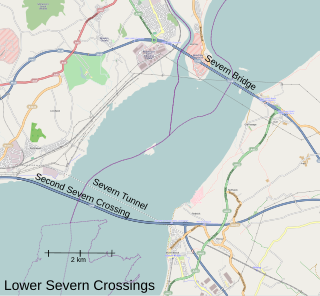
Severn crossing is a term used to refer to the two motorway crossings over the River Severn estuary between England and Wales operated by England's National Highways. The two crossings are:

The Second Severn Crossing, officially renamed the Prince of Wales Bridge since July 2018, is the M4 motorway bridge over the River Severn between England and Wales, opened in 1996 to supplement the traffic capacity of the Severn Bridge built in 1966. The bridge is operated by England's National Highways. It has a total length of 5,128 metres (16,824 ft).

The Bristol Channel is a major inlet in the island of Great Britain, separating South Wales from Devon and Somerset in South West England. It extends from the lower estuary of the River Severn to the North Atlantic Ocean. It takes its name from the English city of Bristol, and is over 30 miles (50 km) wide at its western limit.

Tidal power or tidal energy is harnessed by converting energy from tides into useful forms of power, mainly electricity using various methods.
The Renewables Obligation (RO) is designed to encourage generation of electricity from eligible renewable sources in the United Kingdom. It was introduced in England and Wales and in a different form in Scotland in April 2002 and in Northern Ireland in April 2005, replacing the Non-Fossil Fuel Obligation which operated from 1990.

The Severn Estuary is the estuary of the River Severn, flowing into the Bristol Channel between South West England and South Wales. Its high tidal range, approximately 50 feet (15 m), means that it has been at the centre of discussions in the UK regarding renewable energy.
RWE AG is a German multinational energy company headquartered in Essen. It generates and trades electricity in Asia-Pacific, Europe and the United States. The company is the world's number two in offshore wind power and Europe's third largest company in renewable energy. In the 2020 Forbes Global 2000, RWE Group was ranked as the 297th-largest public company in the world.

Engie Energy International, formerly International Power, is a multinational electricity generation company headquartered in Newcastle upon Tyne, and a wholly owned subsidiary of the French company Engie.
Nuclear power in the United Kingdom generated 16.1% of the country's electricity in 2020. As of August 2022, the UK has 9 operational nuclear reactors at five locations, producing 5.9 GWe. It also has nuclear reprocessing plants at Sellafield and the Tails Management Facility (TMF) operated by Urenco in Capenhurst.

The Severn Barrage is any of a range of ideas for building a barrage from the English coast to the Welsh coast over the Severn tidal estuary. Ideas for damming or barraging the Severn estuary have existed since the 19th century. The building of such a barrage would constitute an engineering project comparable with some of the world's biggest. The purposes of such a project have typically been one or several of: transport links, flood protection, harbour creation, or tidal power generation. In recent decades it is the latter that has grown to be the primary focus for barrage ideas, and the others are now seen as useful side-effects. Following the Severn Tidal Power Feasibility Study (2008–10), the British government concluded that there was no strategic case for building a barrage but to continue to investigate emerging technologies. In June 2013 the Energy and Climate Change Select Committee published its findings after an eight-month study of the arguments for and against the Barrage. MPs said the case for the barrage was unproven. They were not convinced the economic case was strong enough and said the developer, Hafren Power, had failed to answer serious environmental and economic concerns.

Renewable energy in the United Kingdom contributes to production for electricity, heat, and transport.
Halcrow Group Limited was a multinational engineering consultancy company, based in the United Kingdom
Severn Tidal Power Feasibility Study is the name of a UK Government feasibility study into a tidal power project looking at the possibility of using the huge tidal range in the Severn Estuary and Bristol Channel to generate electricity.
Fennovoima Ltd is a nuclear power company established by Russian state's nuclear company Rosatom and a consortium of Finnish state-owned power and industrial companies.

A tidal barrage is a dam-like structure used to capture the energy from masses of water moving in and out of a bay or river due to tidal forces.

ACWA Power is a developer, investor, co-owner and operator of a portfolio of power generation and desalinated water production plants currently with presence in 10 countries including in the Middle East and North Africa, Southern Africa and South East Asia regions. ACWA Power’s portfolio, with an investment value in excess of USD 33 billion, can generate more than 22 GW of power and produce 2.5 million m3/day of desalinated water to be delivered on a bulk basis to state utilities and industrial majors on long term off-take contracts under Public-Private-Partnership, Concession and Utility Services Outsourcing models (BOO/BOOT).
Tidal Lagoon Swansea Bay was a proposed tidal lagoon power plant that was to be constructed in Swansea Bay off the south coast of Wales, United Kingdom. Development consent was granted by the UK government in June 2015, and in June 2018 the Welsh Government approved the plan and offered to invest £200 million; however, later that month the UK government withdrew its support on value-for-money grounds. Other options to enable the proposal to go ahead were reportedly still being explored.

The Mersey Barrage is a proposed scheme for building a tidal barrage across the Mersey Estuary. In December 2022, the Liverpool City Region mayor announced cooperation between the City Region and K-water of South Korea, who built and operates the Sihwa Lake Tidal Power Station, in order to construct a similar operation on the River Mersey.

In 2019, Wales generated 27% of its electricity consumption as renewable electricity, an increase from 19% in 2014. The Welsh Government set a target of 70% by 2030. In 2019, Wales was the world's 5th largest exporter of electricity, mainly to Ireland and England. The natural resource base for renewable energy is high by European standards, with the core sources being wind, wave, and tidal. Wales has a long history of renewable energy: in the 1880s, the first house in Wales with electric lighting powered from its own hydro-electric power station was in Plas Tan y Bwlch, Gwynedd. In 1963, the Ffestiniog Power Station was constructed, providing a large scale generation of hydroelectricity, and in November 1973, the Centre for Alternative Technology was opened in Machynlleth.

The Cardiff Capital Region is a city region in Wales, centred on the capital city of Wales, Cardiff, in the southeast of the country. It is a partnership between the ten local authorities of Blaenau Gwent, Bridgend County Borough, Caerphilly County Borough, Cardiff, Merthyr Tydfil County Borough, Monmouthshire, Newport, Rhondda Cynon Taf, Torfaen, and Vale of Glamorgan, local businesses in southeast Wales and other organisations. The regional city deal is funded by the UK Government and Welsh Government. The Cardiff Capital Region includes the cities of Cardiff and Newport, and most of the South Wales Valleys, with the region being coterminous with the area defined as South East Wales.













